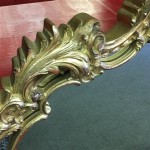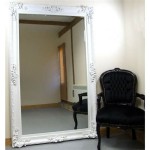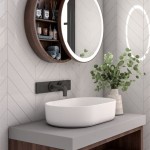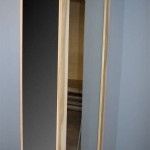Can You Put A Frame on Frameless Mirrors?
Frameless mirrors, characterized by their sleek, minimalist design, have become increasingly popular in contemporary interior design. Their lack of a traditional frame allows them to blend seamlessly into various settings, creating an illusion of spaciousness and reflecting light effectively. However, a common query arises regarding the possibility of adding a frame to these mirrors. The answer is generally yes, but the process involves careful consideration of several factors to ensure a successful and aesthetically pleasing outcome.
The decision to frame a frameless mirror often stems from a desire to enhance its visual impact, integrate it more cohesively with a specific decor style, or provide added protection to the mirror's edges. While frameless mirrors offer a modern appeal, a well-chosen frame can introduce texture, color, and a sense of formality. Understanding the implications of this alteration, from practical considerations to aesthetic choices, is crucial for achieving the desired result.
Assessing the Suitability of Framing a Frameless Mirror
Before embarking on the process of framing a frameless mirror, a thorough assessment of its suitability for framing is essential. This involves evaluating the mirror's size, shape, mounting method, and the surrounding environment. Factors like the mirror's thickness and the type of adhesive used for mounting (if any) can significantly impact the ease and feasibility of adding a frame.
Consider the weight of the mirror. Large, thick mirrors, once framed, can become significantly heavier, potentially straining the existing mounting hardware or requiring reinforcement. Similarly, if the mirror is glued directly to the wall, removing it without causing damage to the mirror or the wall can prove challenging. In such cases, adding a frame directly onto the mirror while it remains in place might be the only viable option, necessitating a different approach to the framing process.
Evaluate the environment where the mirror is located. Mirrors in high-humidity areas, such as bathrooms, require frames that are resistant to moisture. Materials like wood, if not properly sealed, can warp or rot over time. In these settings, frames made of metal, plastic, or composite materials are often more suitable. Furthermore, consider the existing design of the space. The style and color of the frame should complement the overall aesthetic, avoiding clashes or a sense of incongruity.
The shape of the mirror also influences the framing options. While rectangular and square mirrors are relatively straightforward to frame, irregularly shaped mirrors may require custom-made frames, which can be more expensive and time-consuming to fabricate. It is important to carefully measure the mirror's dimensions and account for any irregularities when selecting or designing a frame.
Methods of Attaching a Frame to a Frameless Mirror
Several methods can be employed to attach a frame to a frameless mirror, each with its own set of advantages and disadvantages. The choice of method depends on factors such as the mirror's size and weight, the type of frame material, and the desired level of permanence.
One common approach involves using adhesive. Specialized mirror adhesives, designed to bond securely to both glass and the frame material, are readily available. When using adhesive, it is crucial to select a product that is specifically formulated for mirrors, as other types of adhesives may contain solvents that can damage the reflective backing. The application should be even and cover a sufficient surface area to ensure a strong bond. Clamps or weights can be used to hold the frame in place while the adhesive cures.
Another method involves using clips or brackets. These can be attached to the back of the frame and then secured to the mirror using screws or adhesive. This approach offers a more mechanical connection, which can be particularly beneficial for larger or heavier mirrors. However, it requires careful alignment and precise drilling to avoid damaging the mirror. Furthermore, the clips or brackets should be concealed from view to maintain a clean aesthetic.
A third option involves creating a custom-built frame that encases the mirror. This method typically requires more advanced woodworking skills and tools, but it offers a high degree of customization and control over the final appearance. The frame can be constructed to fit the mirror perfectly, providing a secure and seamless integration. This approach is particularly well-suited for mirrors with irregular shapes or for those seeking a unique and bespoke design.
When selecting an attachment method, consider the potential for future removal. Some adhesives are designed to be permanent, while others can be removed with solvents or heat. If there is a possibility that the frame may need to be removed in the future, a less permanent attachment method, such as clips or brackets, may be preferable.
Selecting the Right Frame
The selection of the right frame is paramount to achieving the desired aesthetic and functional outcome. The frame should complement the mirror's size, shape, and the overall design of the space. Consider the frame's material, style, color, and profile.
Frame materials vary widely, each offering its own unique characteristics. Wood frames provide a warm and traditional look, with options ranging from ornate carvings to simple, clean lines. Metal frames offer a more modern and industrial aesthetic, with finishes such as brushed nickel, polished chrome, and matte black. Plastic and composite frames are lightweight and durable, making them suitable for high-humidity environments. The choice of material should be based on the desired aesthetic, the environmental conditions, and the budget.
The style of the frame should complement the overall decor of the space. A minimalist frame with clean lines is well-suited for a contemporary setting, while an ornate frame with intricate details is more appropriate for a traditional or Victorian-style room. Consider the existing furniture, wall colors, and accessories when selecting a frame style to ensure a cohesive and harmonious look.
The color of the frame should either blend seamlessly with the surrounding environment or provide a striking contrast. A neutral-colored frame, such as white, black, or gray, is a safe choice that can work well in a variety of settings. A bolder color, such as gold, silver, or a vibrant hue, can add a touch of drama and personality. The choice of color should be based on the desired effect and the existing color palette of the space.
The profile of the frame refers to its shape and depth. A thin, flat profile offers a minimalist look, while a thicker, more contoured profile adds depth and dimension. The profile should be chosen based on the size of the mirror and the desired level of visual impact. A larger mirror can typically accommodate a more substantial profile, while a smaller mirror may benefit from a thinner profile to avoid overwhelming the space.
Consider exploring options such as beveled frames, which add an elegant touch with their angled edges, or frames with integrated lighting, which can enhance the mirror's functionality and create a unique ambiance. Ultimately, the selection of the right frame is a matter of personal preference and should be guided by a careful consideration of the factors outlined above.
In conclusion, adding a frame to a frameless mirror is a viable option that can enhance its aesthetic appeal and integrate it more seamlessly into a specific design scheme. By carefully assessing the mirror's suitability for framing, selecting an appropriate attachment method, and choosing a frame that complements the surrounding environment, one can achieve a successful and visually pleasing transformation.

How To Frame Out That Builder Basic Bathroom Mirror For 20 Or Less

How To Frame Out That Builder Basic Bathroom Mirror For 20 Or Less

How To Frame Out That Builder Basic Bathroom Mirror For 20 Or Less

Diy Bathroom Mirror Frame Without Removing Clips Her Happy Home

How To Install A Mirror Without Frame Merrypad

Mirror Frame Diy How To Update A Basic Bathroom Our Faux Farmhouse

Diy Stick On Mirror Frame Sawdust Sisters

How To Frame Out That Builder Basic Bathroom Mirror For 20 Or Less

How To Decorate Your Bathroom With Frameless Mirrors Polaris Home Design

Upgrade Your Mirror With A Mirrormate Frame








